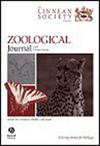水生凯氏蛭的首次化石记录(蝾螈科:Typhlonectidae)
IF 3
2区 生物学
Q1 ZOOLOGY
引用次数: 0
摘要
腔肠动物门(Gymnophiona)支系包括约 220 个公认的现代物种,这些物种被英语白话文称为 "cecilians",其特征是身体细长且呈环状,没有腰带或四肢。尾蜥的化石特别稀少,大多仅限于孤立的脊椎骨。到目前为止,仅有四个真正的Gymnophionomorpha物种是根据化石命名的。其中只有一个物种(Apodops pricei)是皇冠类的无尾类,但它与现代无尾类的亲缘关系并不确定,因为其材料仅限于一个受损的椎骨,而且目前已经丢失。在这里,我们根据部分保存完好的化石骨骼(包括头骨和后颅骨)描述了巴西渐新世特雷门贝地层中的一种新属和新种的凯西利亚人。我们利用高分辨率微计算机断层扫描技术研究了该化石的解剖结构,然后将其与现代物种的骨学进行了比较。我们将该化石解释为栉水母科(Typhlonectidae)的成员,这是一个以水生和半水生生活方式著称的盲鳗科。这一新记录代表了渐新世的第一条无尾类记录,同时也是第一个有把握归属于现生无尾类家族的化石物种。本文章由计算机程序翻译,如有差异,请以英文原文为准。
The first fossil record of an aquatic caecilian (Gymnophiona: Typhlonectidae)
The lissamphibian clade Gymnophiona includes approximately 220 recognized modern species known by the English vernacular as caecilians and characterized by their elongated and annulated bodies, without girdles or limbs. Fossils of caecilians are particularly rare and mostly limited to isolated vertebrae. Until now, only four bona fide Gymnophionomorpha species have been named based on fossils. Only one of these (Apodops pricei) is a crown-group caecilian, but its affinities with modern caecilians are uncertain because the material is limited to one damaged vertebra and is currently lost. Here we describe a new genus and species of caecilian from the Oligocene Tremembé Formation, Brazil, based on a partially preserved fossil skeleton (including elements of the skull and postcranium) that is damaged but still partly articulated. We investigated the fossil caecilian’s anatomy using high-resolution microcomputed tomography, and then compared it to the osteology of modern species. We interpret the fossil as a member of Typhlonectidae, a family of caecilians well known for their aquatic and semi-aquatic lifestyles. This new record represents the first record for caecilians from the Oligocene and also the first fossil species confidently assigned to an extant caecilian family.
求助全文
通过发布文献求助,成功后即可免费获取论文全文。
去求助
来源期刊
CiteScore
6.50
自引率
10.70%
发文量
116
审稿时长
6-12 weeks
期刊介绍:
The Zoological Journal of the Linnean Society publishes papers on systematic and evolutionary zoology and comparative, functional and other studies where relevant to these areas. Studies of extinct as well as living animals are included. Reviews are also published; these may be invited by the Editorial Board, but uninvited reviews may also be considered. The Zoological Journal also has a wide circulation amongst zoologists and although narrowly specialized papers are not excluded, potential authors should bear that readership in mind.

 求助内容:
求助内容: 应助结果提醒方式:
应助结果提醒方式:


